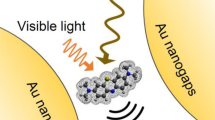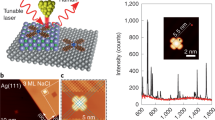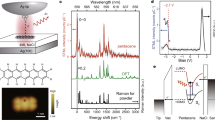Abstract
The internal vibrations of molecules drive the structural transformations that underpin chemistry and cellular function. While vibrational frequencies are measured by spectroscopy, the normal modes of motion are inferred through theory because their visualization would require microscopy with ångström-scale spatial resolution—nearly three orders of magnitude smaller than the diffraction limit in optics1. Using a metallic tip to focus light and taking advantage of the surface-enhanced Raman effect2 to amplify the signal from individual molecules, tip-enhanced Raman spectromicroscopy (TER-SM)3,4 reaches the requisite sub-molecular spatial resolution5, confirming that light can be confined in picocavities6,7,8,9,10 and anticipating the direct visualization of molecular vibrations11,12,13. Here, by using TER-SM at the precisely controllable junction of a cryogenic ultrahigh-vacuum scanning tunnelling microscope14,15,16, we show that ångström-scale resolution is attained at subatomic separation between the tip atom and a molecule in the quantum tunnelling regime of plasmons6,8,9,17. We record vibrational spectra within a single molecule, obtain images of normal modes and atomically parse the intramolecular charges and currents driven by vibrations. Our analysis provides a paradigm for optics in the atomistic near-field.
This is a preview of subscription content, access via your institution
Access options
Access Nature and 54 other Nature Portfolio journals
Get Nature+, our best-value online-access subscription
$29.99 / 30 days
cancel any time
Subscribe to this journal
Receive 51 print issues and online access
$199.00 per year
only $3.90 per issue
Buy this article
- Purchase on Springer Link
- Instant access to full article PDF
Prices may be subject to local taxes which are calculated during checkout




Similar content being viewed by others
References
Betzig, E. Nobel lecture: single molecules, cells, and super-resolution optics. Rev. Mod. Phys. 87, 1153–1168 (2015).
Jeanmaire, D. L. & Van Duyne, R. P. Surface Raman spectroelectrochemistry: part I. Heterocyclic, aromatic, and aliphatic amines adsorbed on the anodized silver electrode. J. Electroanal. Chem. 84, 1–20 (1977).
Jiang, N. et al. Tip-enhanced Raman spectroscopy: from concepts to practical applications. Chem. Phys. Lett. 659, 16–24 (2016).
Stöckle, R. M., Suh, Y. D., Deckert, V. & Zenobi, R. Nanoscale chemical analysis by tip-enhanced Raman spectroscopy. Chem. Phys. Lett. 318, 131–136 (2000).
Zhang, R. et al. Chemical mapping of a single molecule by plasmon-enhanced Raman scattering. Nature 498, 82–86 (2013).
Zhang, P., Feist, J., Rubio, A., García-González, P. & García-Vidal, F. J. Ab initio nanoplasmonics: the impact of atomic structure. Phys. Rev. B 90, 161407 (2014).
Trautmann, S. et al. A classical description of subnanometer resolution by atomic features in metallic structures. Nanoscale 9, 391–401 (2017).
Urbieta, M. et al. Atomic-scale lightning rod effect in plasmonic picocavities: a classical view to a quantum effect. ACS Nano 12, 585–595 (2018).
Chen, X. & Jensen, L. Morphology dependent near-field response in atomistic plasmonic nanocavities. Nanoscale 10, 11410–11417 (2018).
Benz, F. et al. Single-molecule optomechanics in ‘picocavities’. Science 354, 726–729 (2016).
Duan, S. et al. Theoretical modeling of plasmon-enhanced Raman images of a single molecule with subnanometer resolution. J. Am. Chem. Soc. 137, 9515–9518 (2015).
Duan, S., Tian, G. & Luo, Y. Visualization of vibrational modes in real space by tip-enhanced non-resonant Raman spectroscopy. Angew. Chem. Int. Ed. 55, 1041–1045 (2016).
Liu, P., Chulhai, D. V. & Jensen, L. Single-molecule imaging using atomistic near-field tip-enhanced Raman spectroscopy. ACS Nano 11, 5094–5102 (2017).
Pozzi, E. A. et al. Ultrahigh-vacuum tip-enhanced Raman spectroscopy. Chem. Rev. 117, 4961–4982 (2017).
Steidtner, J. & Pettinger, B. Tip-enhanced Raman spectroscopy and microscopy on single dye molecules with 15 nm resolution. Phys. Rev. Lett. 100, 236101 (2008).
Chiang, N. et al. Molecular-resolution interrogation of a porphyrin monolayer by ultrahigh vacuum tip-enhanced Raman and fluorescence spectroscopy. Nano Lett. 15, 4114–4120 (2015).
Savage, K. J. et al. Revealing the quantum regime in tunnelling plasmonics. Nature 491, 574–577 (2012).
Moskovits, M. Criterion for determining resolving power in the optical near field. J. Nanophotonics 11, 046018 (2017).
Lee, J. et al. Tip-enhanced Raman spectromicroscopy of Co(ii)-tetraphenylporphyrin on Au(111): toward the chemists’ microscope. ACS Nano 11, 11466–11474 (2017).
Tallarida, N., Rios, L., Apkarian, V. A. & Lee, J. Isomerization of one molecule observed through tip-enhanced Raman spectroscopy. Nano Lett. 15, 6386–6394 (2015).
Tallarida, N., Lee, J. & Apkarian, V. A. Tip-enhanced Raman spectromicroscopy on the angstrom scale: bare and CO-terminated Ag tips. ACS Nano 11, 11393–11401 (2017).
Hugall, J. T. & Baumberg, J. J. Demonstrating photoluminescence from au is electronic inelastic light scattering of a plasmonic metal: the origin of SERS backgrounds. Nano Lett. 15, 2600–2604 (2015).
Dey, S. et al. Observation and analysis of Fano-like lineshapes in the Raman spectra of molecules adsorbed at metal interfaces. Phys. Rev. B 93, 035411 (2016).
Lee, J., Tallarida, N., Chen, X., Jensen, L. & Apkarian, V. A. Microscopy with a single-molecule scanning electrometer. Sci. Adv. 4, eaat5472 (2018).
Le Ru, E. C. & Etchegoin, P. G. Rigorous justification of the |E|4 enhancement factor in surface enhanced Raman spectroscopy. Chem. Phys. Lett. 423, 63–66 (2006).
Lee, J. et al. Orbiting orbitals: visualization of vibronic motion at a conical intersection. J. Phys. Chem. A 117, 11655–11664 (2013).
Banik, M. et al. Surface-enhanced Raman trajectories on a nano-dumbbell: transition from field to charge transfer plasmons as the spheres fuse. ACS Nano 6, 10343–10354 (2012).
Di Santo, G. et al. Conformational adaptation and electronic structure of 2H-tetraphenylporphyrin on Ag(111) during Fe metalation. J. Phys. Chem. C 115, 4155–4162 (2011).
Smoluchowski, R. Anisotropy of the electronic work function of metals. Phys. Rev. 60, 661–674 (1941).
Hirshfeld, F. L. Bonded-atom fragments for describing molecular charge densities. Theor. Chim. Acta 44, 129–138 (1977).
Marenich, A. V., Cramer, C. J. & Truhlar, D. G. Reduced and quenched polarizabilities of interior atoms in molecules. Chem. Sci. 4, 2349–2356 (2013).
Gough, K. M., Srivastava, H. K. & Belohorcová, K. Analysis of Raman trace scattering intensities in alkanes with the theory of atoms in molecules. J. Chem. Phys. 98, 9669–9677 (1993).
Frisch, M. J. et al. Gaussian 09, Revision C.01 (Gaussian, Inc., Wallingford, 2010).
Acknowledgements
This research was supported by the NSF Center for Chemical Innovation dedicated to Chemistry at the Space-Time Limit (CHE-1414466). Theoretical calculations were performed on the UCI Greenplanet cluster system (CHE-0840513). We thank P. El-Khoury for advice on DFT calculations. We have benefited from discussions with L. Jensen, X. Chen and P. Liu.
Reviewer information
Nature thanks Eric Le Ru and the other anonymous reviewer(s) for their contribution to the peer review of this work.
Author information
Authors and Affiliations
Contributions
J.L. and K.T.C. carried out experimental work and data analysis. J.L. performed theoretical simulations. N.T. produced nanoscopically smooth silver tips and performed preliminary principal component analysis. J.L. and V.A.A. conceived and coordinated the project and authored the paper with input from all co-authors.
Corresponding authors
Ethics declarations
Competing interests
The authors declare no competing interests.
Additional information
Publisher’s note: Springer Nature remains neutral with regard to jurisdictional claims in published maps and institutional affiliations.
Extended data figures and tables
Extended Data Fig. 1 Conformational transformation of CoTPP on Cu(100).
a, An imaging sequence starting at −0.5 V is followed by repeated scans at –12 mV. The size of the images is 35 × 35 Å2. The pressing scanning condition at −12 mV leads to planarity of the phenyl groups. b, Optimized geometry of a free CoTPP molecule and flat geometry of an adsorbed CoTPP molecule with artificially flattened phenyl rings. c, Lattice registry of the flat CoTPP and the marker CO molecule, which adsorbs on the copper on-top site.
Extended Data Fig. 2 Disappearance of the Kondo resonance.
The Kondo resonance observed on the saddled CoTPP adsorbed on the Au(111) surface disappears on the flat CoTPP adsorbed on the Cu(100) surface. The gap distances are set at 1 nA, +0.2 V and 1 nA, −0.2 V for Au and Cu, respectively.
Extended Data Fig. 3 Gap dependence of Raman intensity and vibrational frequency.
a, b, Measurements on cobalt (a) and pyrrole (b). Colour-coded vertical grid lines in the leftmost graph indicate vibrational modes analysed in terms of intensity and frequency shift in the middle and right panels, respectively. The extracted powers n from the curve fit (I = az−n) are indicated in the corresponding colours.
Extended Data Fig. 4 Maps of omitted normal modes.
The modes presented here are extensively delocalized and do not yield unique assignments.
Extended Data Fig. 5 Dominance of Δαzz in the observed TERS.
Raman images of the 388-cm−1 mode, simulated using out-of-plane (zz) and in-plane (xx) polarizability differences, and the map of the xx component of the polarizability at equilibrium (α0,xx). The Δαzz component reproduces the experiment, whereas the Δαxx fails despite its large magnitude. The charge accumulation at the edges upon polarization is demonstrated in both Δαxx and α0,xx. This trend applies to all of the observed normal modes.
Extended Data Fig. 6 Vibrational Stark effect of the C–H stretch.
Evolution of the C–H stretch upon tuning of the integration window. The image size and resolution are 28 × 28 Å2 and 80 × 80 pixels, respectively. Images are low-pass-filtered for clarity.
Extended Data Fig. 7 Schematic diagram for the resolution of near-field optical microscopy.
a, Local electric field along the z axis, Ez, arising from a charge. Only the z component is considered because in-plane dipoles induced by tangential components are cancelled by their images in the metallic substrate. b, Comparison between the fourth power of the Coulomb field distribution (q = 1) and equivalent Gaussian with the associated FWHM value.
Extended Data Fig. 8 Selection rules of atomistic TERS.
Top right, orientationally averaged Raman spectrum of the free molecule. The intensities of the selected vibrational modes shown in Fig. 3 are indicated by red dots and dashed lines. Bottom right, atomic polarizability differences and their colour-coded amplitudes in atomic units. The colour represents the phase of the out-of-plane atomic dynamic dipole associated with \({\alpha }_{zz}^{i}\). Left, while a nonlocal excitation leads to the cancellation of induced dipoles (top), the atomistic near field samples each radiating vertical dipole that is reinforced by its image (bottom). h0 and σ0 are Rayleigh length and waist, respectively, as defined in ‘Gaussian optics’ in Methods.
Rights and permissions
About this article
Cite this article
Lee, J., Crampton, K.T., Tallarida, N. et al. Visualizing vibrational normal modes of a single molecule with atomically confined light. Nature 568, 78–82 (2019). https://doi.org/10.1038/s41586-019-1059-9
Received:
Accepted:
Published:
Issue Date:
DOI: https://doi.org/10.1038/s41586-019-1059-9
This article is cited by
-
Submolecular-scale control of phototautomerization
Nature Nanotechnology (2024)
-
Noise learning of instruments for high-contrast, high-resolution and fast hyperspectral microscopy and nanoscopy
Nature Communications (2024)
-
Ultrafast atomic-scale scanning tunnelling spectroscopy of a single vacancy in a monolayer crystal
Nature Photonics (2024)
-
Deposition of hydrophilic Ti3C2Tx on a superhydrophobic ZnO nanorod array for improved surface-enhanced raman scattering performance
Journal of Nanobiotechnology (2023)
-
The role of halogens in Au–S bond cleavage for energy-differentiated catalysis at the single-bond limit
Nature Communications (2023)
Comments
By submitting a comment you agree to abide by our Terms and Community Guidelines. If you find something abusive or that does not comply with our terms or guidelines please flag it as inappropriate.



